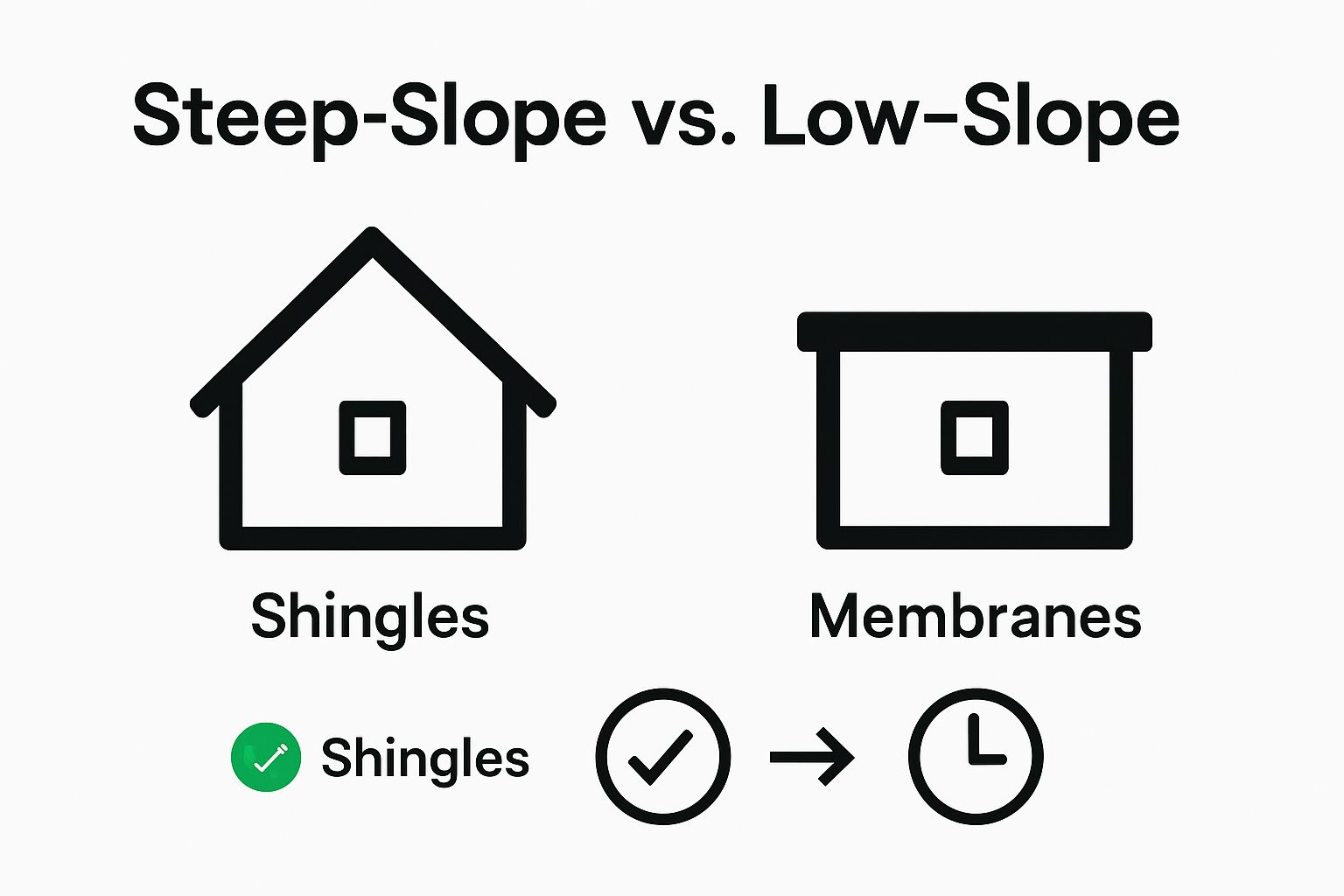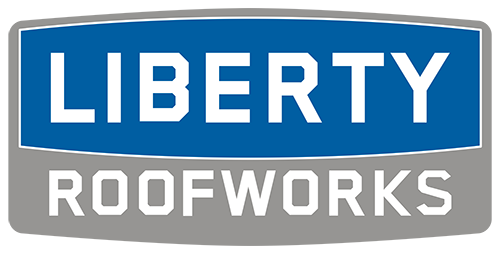Roofing systems might look simple from the street, but the science behind them is anything but basic. Some materials can double a home’s energy efficiency depending on their type and how well they are installed. Most people focus only on what color or style to put on their house, yet the biggest impact often comes from what is hiding just beneath the surface.
Table of Contents
- Key Types Of Roofing Systems And Their Features
- Why Roofing Material Choices Matter For Longevity And Safety
- How Different Roof Types Perform Against Weather Conditions
- Innovations In Roofing Systems: Trends For 2025
- Choosing The Right Roofing System For Your Needs
Quick Summary
| Takeaway | Explanation |
|---|---|
| Select roofing based on slope type | Choose between steep-slope or low-slope systems based on your building’s structure and purpose. |
| Prioritize material for longevity | The right roofing material impacts energy efficiency, safety, and structural integrity over time. |
| Consider local climate for performance | Evaluate how different roofing materials handle regional weather conditions to ensure resilience and effectiveness. |
| Innovative roofing can enhance value | Look for advancements like solar integration and eco-friendly materials that contribute to energy efficiency and home sustainability. |
| Total cost analysis for roofing choices | Assess not only initial costs but also long-term maintenance and energy savings for a smarter financial decision. |
Key Types of Roofing Systems and Their Features
Understanding the various types of roofing systems is crucial for homeowners seeking durable and efficient protection for their homes. Roofing systems are not one-size-fits-all solutions but complex assemblies designed to shield your property from environmental challenges. Our comprehensive guide on roofing systems can help you navigate these critical home infrastructure choices.
Structural Classifications of Roofing Systems
Roofing systems are primarily categorized based on their design, slope, and materials. The primary classifications include steep-slope and low-slope roofing systems, each with unique characteristics and applications. Research from the National Renewable Energy Laboratory highlights the importance of selecting the right roofing system for optimal energy efficiency and long-term performance.
Steep-Slope Roofing Systems
Steep-slope roofs typically have an angle greater than 3:12 pitch and are most common in residential settings. These systems include popular materials such as:
- Asphalt shingles
- Wood shakes
- Metal roofing panels
- Clay or concrete tiles
- Synthetic slate
Low-Slope Roofing Systems
Low-slope roofs with a pitch less than 3:12 are predominantly used in commercial and industrial buildings. These systems prioritize waterproofing and typically employ:
- Built-up roofing (BUR)
- Modified bitumen
- Single-ply membranes like TPO and EPDM
- Spray polyurethane foam
Each roofing system offers distinct advantages in terms of durability, cost-effectiveness, energy efficiency, and aesthetic appeal.
Below is a comparison table summarizing the key features and applications of steep-slope and low-slope roofing systems to help homeowners differentiate between these two major categories.
| Roofing System Type | Typical Slope | Common Materials | Primary Applications | Key Advantages |
|---|---|---|---|---|
| Steep-Slope | Greater than 3:12 | Asphalt shingles, wood shakes, metal panels, | Residential homes | Better water runoff, varied styles, |
| clay or concrete tiles, synthetic slate | straightforward maintenance | |||
| Low-Slope | Less than 3:12 | Built-up roofing (BUR), modified bitumen, | Commercial and industrial | Superior waterproofing, allows |
| single-ply membranes (TPO, EPDM), spray foam | buildings | for larger roof spans |
 Homeowners must consider factors like local climate, building structure, budget, and long-term maintenance requirements when selecting a roofing system.
Homeowners must consider factors like local climate, building structure, budget, and long-term maintenance requirements when selecting a roofing system.
Why Roofing Material Choices Matter for Longevity and Safety
Choosing the right roofing material is more than an aesthetic decision. It represents a critical investment in your home’s structural integrity, energy efficiency, and long-term protection. Learn how to select the best roofing material to ensure maximum performance and durability.
Environmental Impact and Performance
Roofing materials directly influence a home’s resilience against environmental challenges. Different materials respond uniquely to temperature variations, precipitation, UV exposure, and wind loads. Research from the National Institute of Standards and Technology demonstrates that material selection significantly affects a roof’s ability to withstand extreme weather conditions.
Critical Factors in Material Selection
Homeowners must consider several key factors when evaluating roofing materials:
- Climate and regional weather patterns
- Structural load-bearing capacity
- Energy efficiency ratings
- Expected maintenance requirements
- Initial and long-term cost considerations
Safety and Structural Integrity
Beyond environmental protection, roofing materials play a crucial role in home safety. High-quality materials contribute to fire resistance, impact durability, and overall structural stability. Some materials offer superior protection against potential hazards like falling debris, hail damage, and potential structural compromises.
Performance Metrics to Consider
When assessing roofing materials, evaluate these essential safety characteristics:
- Fire resistance ratings
- Wind uplift resistance
- Impact resistance (hail and debris)
- Thermal insulation properties
- Moisture and rot resistance
The right roofing material serves as a critical barrier between your home and external elements, providing comprehensive protection while contributing to energy efficiency and long-term structural health.
The following table outlines performance metrics and critical factors that should be considered when evaluating different roofing material options for safety, longevity, and environmental resistance.
| Criterion | Description | Why It Matters |
|---|---|---|
| Fire Resistance | Material’s ability to withstand fire exposure | Improves overall home safety |
| Wind Uplift Resistance | Withstands high winds without lifting or damage | Essential for storm-prone areas |
| Impact Resistance | Resists hail, debris, and falling objects | Reduces risk of punctures/damage |
| Thermal Insulation | Limits heat transfer to maintain indoor temperature | Enhances energy efficiency |
| Moisture and Rot Resistance | Prevents water intrusion and material decay | Prolongs roof and structural health |
| Maintenance Requirements | Level of care needed to sustain optimal performance | Affects long-term cost and upkeep |
| Initial and Long-Term Cost | Total expenses for purchase, installation, and lifespan upkeep | Guides cost-effective decisions |

How Different Roof Types Perform Against Weather Conditions
Weather conditions pose significant challenges to roofing systems, with each material and design responding differently to environmental stressors. Learn more about common residential roof types for various climates to understand how your roofing choice impacts long-term performance.
Temperature and Thermal Performance
Roof materials react uniquely to temperature fluctuations, with thermal expansion and contraction creating potential structural challenges. Research from the Insurance Institute for Business & Home Safety demonstrates how different roofing systems manage heat transfer and thermal stress.
Thermal Resistance Characteristics
Various roofing materials exhibit different thermal performance attributes:
- Metal roofs reflect solar radiation
- Clay tiles provide excellent insulation
- Asphalt shingles absorb and retain heat
- White or light-colored roofs reduce heat absorption
- Green roofs offer natural temperature regulation
Wind and Impact Resistance
Wind represents a critical factor in roof system durability. Roof design, material selection, and installation techniques collectively determine a roof’s ability to withstand high-velocity winds and impact events. Proper installation and material selection are crucial for maintaining structural integrity during severe weather conditions.
Wind Performance Metrics
Roofing systems are evaluated based on several wind resistance factors:
- Wind uplift ratings
- Fastening mechanism strength
- Material flexibility
- Edge reinforcement techniques
- Structural attachment methods
Understanding how different roofing systems perform against varied weather conditions helps homeowners make informed decisions that protect their property and ensure long-term structural resilience.
Innovations in Roofing Systems: Trends for 2025
The roofing industry is experiencing rapid technological transformation, driven by sustainability, energy efficiency, and advanced material science. Learn about the latest cool roofing standards for 2025 to stay ahead of emerging residential roofing trends.
Sustainable and Smart Roofing Technologies
Research from the National Renewable Energy Laboratory indicates significant advancements in roofing systems that go beyond traditional protection. Modern roofing innovations are integrating intelligent technologies and sustainable materials to create multifunctional building envelopes.
Emerging Roofing Technology Trends
Key technological developments in roofing systems include:
- Solar integrated roofing materials
- Self-healing membrane technologies
- Advanced thermal regulation surfaces
- Integrated moisture and damage detection systems
- Nanotechnology-enhanced protective coatings
Energy Efficiency and Environmental Performance
Green Roofing Innovations
Environmentally conscious roofing systems are becoming increasingly sophisticated, offering homeowners multiple benefits beyond traditional protective functions:
- Carbon-negative roofing materials
- Enhanced thermal insulation technologies
- Rainwater harvesting integrated roof designs
- Photocatalytic surfaces that reduce urban heat islands
- Recyclable and biodegradable roofing components
These innovations represent a significant leap forward in creating roofing systems that are not just protective barriers, but active contributors to sustainable and intelligent home environments.
Choosing the Right Roofing System for Your Needs
Selecting an appropriate roofing system requires careful consideration of multiple factors beyond aesthetic preferences. Understand why cheap roof systems might cost more in the long run to make an informed investment decision that protects your property.
Comprehensive Evaluation Criteria
Research from the National Roofing Contractors Association highlights the importance of a holistic approach to roof system selection. Homeowners must evaluate multiple interconnected factors to ensure optimal performance and longevity.
Critical Selection Factors
Key considerations when choosing a roofing system include:
- Local climate and environmental conditions
- Building structural characteristics
- Budget constraints
- Long-term maintenance requirements
- Energy efficiency goals
- Aesthetic preferences
Financial and Performance Considerations
Total Cost of Ownership Analysis
Beyond initial installation expenses, homeowners should assess the comprehensive financial implications of their roofing system:
- Initial material and installation costs
- Expected lifespan of roofing materials
- Annual maintenance expenses
- Energy efficiency potential
- Potential insurance premium impacts
- Resale value contribution
A strategic approach to roofing system selection involves balancing immediate affordability with long-term performance, ensuring your investment provides maximum protection and value for your specific residential requirements.
Ready to Protect Your Home with the Right Roofing System?
You have learned how the right roofing system impacts everything from energy efficiency to safety and long-term cost. With so many choices, it is normal to feel unsure about which option will keep your home safe through changing weather and time. Many homeowners struggle to balance durability, performance, and style, especially when facing concerns like storm damage or rising maintenance costs. The article outlined how vital factors like material choice, local climate, and installation quality are to your investment.
Let Liberty Roofworks help you take the next step with confidence. As Charlotte’s trusted experts, we offer residential solutions such as roof repair and replacements that match the latest advances in roofing systems. If you want to learn more or need a personalized assessment, visit Liberty Roofworks now. Discover how the right system installed by true professionals keeps your family, property, and peace of mind protected. Schedule your consultation today and make a real difference for your home.
Frequently Asked Questions
What are the key types of roofing systems available for homes in 2025?
The main types of roofing systems include steep-slope roofs (like asphalt shingles, wood shakes, metal roofing, and clay tiles) and low-slope roofs (such as built-up roofing, modified bitumen, and single-ply membranes). Each type offers unique advantages in terms of durability, cost, energy efficiency, and aesthetic appeal.
How do I choose the right roofing material for my home?
When selecting roofing materials, consider factors such as local climate, energy efficiency ratings, structural load-bearing capacity, maintenance requirements, and initial as well as long-term costs. It’s essential to evaluate how these factors align with your specific needs and environment.
What impact do roofing materials have on home safety?
High-quality roofing materials enhance home safety by providing fire resistance, impact durability, and structural stability. Certain materials can protect against hazards like falling debris and severe weather, ensuring the integrity of your home.
What innovations in roofing systems should homeowners look for in 2025?
Innovations to watch for include sustainable roofing materials, solar-integrated roofs, advanced thermal regulation surfaces, self-healing membranes, and technology-enhanced features like moisture detection systems. These advancements aim to improve energy efficiency and create environmentally friendly roofing solutions.
